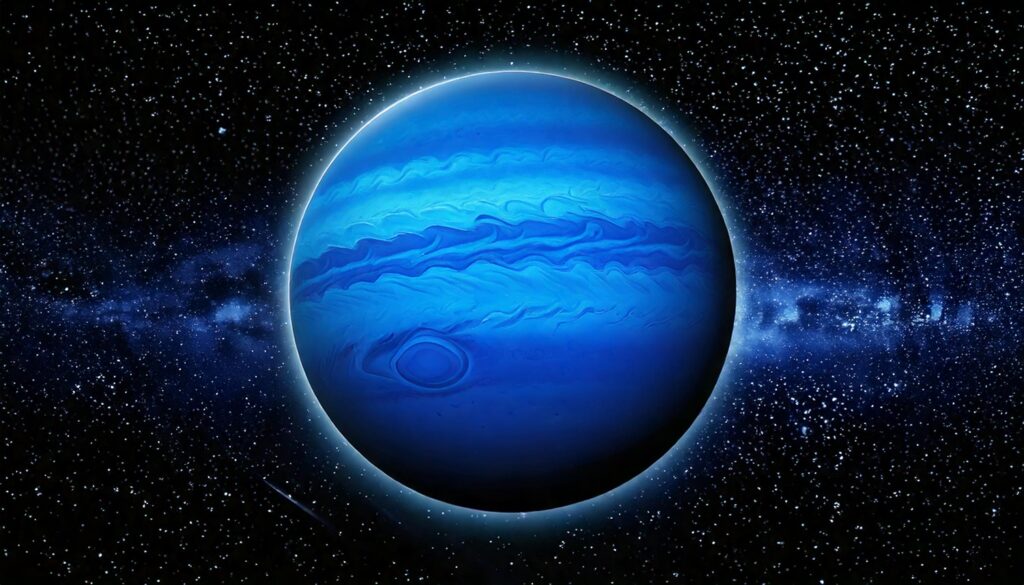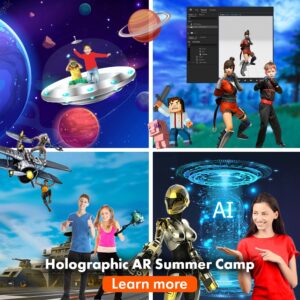
The “Neptune Exploration with AR & AI” project offers elementary teachers an engaging way to introduce students to the wonders of Neptune, the farthest planet in our solar system. Using a basic setup—Windows or Mac computer with a webcam, connected to a projector, TV, or smart board—teachers can transform their classroom into an interactive space where students can explore Neptune’s unique features, such as its powerful winds, dark and cold environment, and extreme distance from the Sun.
This free resource aligns with NGSS standards and uses immersive AR stages to promote hands-on learning and critical thinking. Each lesson guides students through Neptune’s environment with visual AR effects and interactive AI prompts that spark curiosity and make abstract concepts more concrete. Read on for a full guide on how to bring Neptune’s mysteries to your classroom with this accessible, enriching project.
Instruction Guide
Introduction to the Project:
- Stage 1: Meet Neptune – Introduce Neptune as the eighth and farthest planet from the Sun, highlighting its size, cold and windy conditions, and unique place in our solar system.
- Stage 2: The Windy World – Explore Neptune’s powerful winds, which blow faster than the speed of sound, showcasing Neptune’s extreme and unusual weather.
- Stage 3: A Day and Year on Neptune – Explain how time works on Neptune, including its short days (16 hours) and long orbit around the Sun (165 Earth years).
- Stage 4: Neptune’s Distance from the Sun – Discuss Neptune’s position as the farthest major planet from the Sun and how its distance affects temperature and brightness.
- Stage 5: Reflection and Review – Summarize Neptune’s characteristics, emphasizing its size, extreme winds, distance, and long orbit, encouraging further curiosity about space.
Each stage integrates narration and interactive activities to encourage critical thinking and hands-on engagement with Neptune’s unique features.
Learning Objectives and Outcomes
Learning Objectives with NGSS Standards Alignment:
- Understand Neptune’s Position, Size, and Composition
- Objective: Students will learn that Neptune is the farthest planet in the solar system, much larger than Earth, with cold and windy conditions.
- NGSS Alignment: ESS1.B: Earth and the Solar System – Understand differences in planetary sizes, distances, and environments.
- NGSS Code: 5-ESS1-3 – Recognize patterns in planetary size and distance.
- Explore Neptune’s Windy Atmosphere
- Objective: Students will learn about Neptune’s extreme wind speeds, including those that move faster than the speed of sound.
- NGSS Alignment: ESS1.B: Earth and the Solar System – Study unique planetary atmospheres and environments.
- NGSS Code: 5-ESS1-3 – Describe unusual weather patterns on Neptune.
- Investigate Neptune’s Orbital Characteristics
- Objective: Students will understand the relationship between Neptune’s distance from the Sun and its lengthy orbit.
- NGSS Alignment: ESS1.B: Earth and the Solar System – Examine how planetary distances affect orbital length and environmental conditions.
- NGSS Code: 5-ESS1-3 – Recognize patterns related to orbital distance and duration.
- Explore Cause and Effect on Neptune’s Conditions
- Objective: Students will consider how distance from the Sun affects Neptune’s cold, dark environment and its long year.
- NGSS Alignment: ESS2.D: Weather and Climate – Understand how planetary distance impacts environmental factors.
- NGSS Code: 5-ESS1-3 – Analyze how distance influences environmental and orbital patterns.
Learning Outcomes:
- Outcome 1: Students can describe Neptune’s characteristics, including size, wind speeds, distance, and orbit.
- Outcome 2: Students can explain how Neptune’s distance from the Sun affects its environment and orbital characteristics.
- Outcome 3: Students apply scientific vocabulary, aligned with NGSS and Common Core standards, to describe Neptune’s unique conditions.
Classroom Activity Design
Pre-Project Activities (Warm-Up & Background Building)
- Planetary Size Comparison Warm-Up
- Objective: Help students grasp the size of Neptune compared to Earth.
- Activity: Use visuals or models to show that Earth would be the size of an apple compared to Neptune as a basketball.
- Outcome: Provides context for Neptune’s size and prepares students to explore planetary distances.
- Extreme Weather Patterns and Winds
- Objective: Introduce Neptune’s windy environment, comparing it to Earth’s storms.
- Activity: Show a short video of extreme weather on Earth, then ask students to imagine even faster winds on Neptune.
- Outcome: Prepares students to understand the scale of Neptune’s windy atmosphere.
Interactive Project: Neptune Exploration with AI and Visuals
- Guided Experience: Students explore Neptune’s size, extreme winds, orbit, and distance from the Sun through narration and visual aids.
- AI Interaction: Students answer prompts about Neptune’s winds, orbit, and conditions, observing each aspect that makes Neptune unique.
Post-Project Activities (Reinforcement & Hands-On Learning)
- Neptune’s Key Features Discussion
- Objective: Reinforce main concepts learned about Neptune.
- Activity: In small groups, students discuss key facts about Neptune’s size, winds, orbit, and distance from the Sun. Each group presents one fact they found surprising.
- Outcome: Summarizes main points and reinforces comprehension through collaboration.
- Wind Speed Simulation (Hands-On)
- Objective: Demonstrate how Neptune’s winds compare to the speed of sound.
- Activity: Use sound and movement exercises to help students understand how quickly sound travels compared to Neptune’s winds.
- Outcome: Tangibly illustrates the concept of wind speed and sound, linking it to Neptune’s environment.
- Orbit and Distance Model
- Objective: Help students visualize Neptune’s long orbit and its distance from the Sun.
- Activity: Students create a simple 3D model with Neptune and the Sun to illustrate its far orbit.
- Outcome: Reinforces understanding of Neptune’s distance and its effect on the length of its year.
Classroom Management Tips
- Clear Viewing: Arrange seating for clear viewing of visuals, ensuring all students can engage with the Neptune model.
- Rotate Participation: Assign different prompts or questions to students during each stage to encourage active involvement.
- Encourage Prepared Responses: Before starting, help students think through answers to AI prompts, boosting their confidence and engagement.
- Inclusive Participation: Pay attention to quieter students, encouraging participation with roles or prompts.
- Praise and Recognition: Provide positive feedback for each student’s contributions to create a supportive learning environment.
- Manage Turn-Taking: Ensure fair access to hands-on activities by guiding enthusiastic students to give others a chance.
Formative Assessments
- Quick Facts Check: After each stage, ask students to share one new thing they learned, such as the reason for Neptune’s fast winds or long year.
- Reflection Journal: Students write a journal entry summarizing the most interesting thing about Neptune. Example prompts:
- “Describe one unique thing about Neptune.”
- “What surprised you about Neptune’s winds or distance from the Sun?”
- Neptune and Earth Comparison Worksheet
- What It Is: A worksheet where students compare Neptune and Earth based on size, winds, distance, and orbital length.
- Purpose: Reinforces understanding of Neptune’s features by contrasting it with Earth, making planetary differences clear.
- Wind Speed Reflection
- What It Is: After the wind speed simulation, students describe how Neptune’s winds compare to Earth’s.
- Purpose: Reinforces understanding of atmospheric speed and conditions.
Cross-Subject Integration Suggestions
- Math: Calculate distances in astronomical units to understand Neptune’s far orbit.
- Art: Have students draw Neptune, adding details of its dark blue color and atmosphere.
- Language Arts: Write a paragraph describing what it would be like to visit Neptune, incorporating vocabulary like “windy,” “distance,” and “cold.”
- History/Social Studies: Discuss the discovery of Neptune and how scientists study planets that are so far from Earth.




Recent Comments